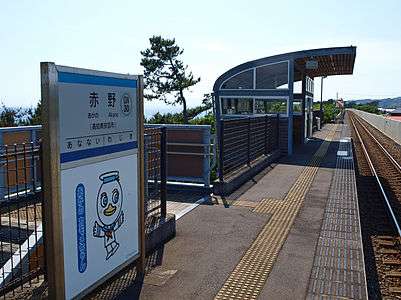Akano Station
Akano Station (赤野駅, Akano-eki) is railway station on the Asa Line in Aki, Kōchi Prefecture, Japan. It is operated by the third-sector Tosa Kuroshio Railway with the station number "GN30".[1][2]
Akano Station 赤野駅 | |
|---|---|
 Akano Station in 2007 | |
| Location | Akanootsu, Aki-shi, Kōchi-ken 784-0034 Japan |
| Coordinates | 33°30′58″N 133°49′28″E |
| Operated by | Tosa Kuroshio Railway |
| Line(s) | ■ Asa Line |
| Distance | 19.6 km from Gomen |
| Platforms | 1 side platform |
| Tracks | 1 |
| Construction | |
| Structure type | Elevated |
| Parking | Available |
| Bicycle facilities | Bike shed |
| Disabled access | No - steps lead up to platform |
| Other information | |
| Status | Unstaffed |
| Station code | GN30 |
| History | |
| Opened | 1 July 2002 |
| Traffic | |
| Passengers (FY2011) | 42 daily |
| Location | |
 Akano Station Location within Japan | |
Lines
The station is served by the Asa Line and is located 19.6 km from the beginning of the line at Gomen.[3] Only local trains stop at the station.[4]
Layout
The station consists of a side platform serving a single elevated track. There is no station building and the station is unstaffed but a shelter comprising both an open and an enclosed compartment is provided on the platform for waiting passengers. Access to the platform is by means of a flight of steps. Another waiting room is provided near the station entrance at the base of the elevated structure, together with parking lots and a bike shed.[2][3][5]
Station mascot
Each station on the Asa Line features a cartoon mascot character designed by Takashi Yanase, a local cartoonist from Kōchi Prefecture. The mascot for Akano Station is a figure of a seagull dressed in a sailor suit named Akano Kamome-chan (あかの カモメちゃん). The design is chosen because the line runs by the coast of the Pacific Ocean near the station and many seagulls can be seen in the area.[6]
 A picture of the mascot can be seen under the station name board.
A picture of the mascot can be seen under the station name board.
History
The train station was opened on 1 July 2002 by the Tosa Kuroshio Railway as an intermediate station on its track from Gomen to Nahari.[7]
Passenger statistics
In fiscal 2011, the station was used by an average of 42 passengers daily.[7]
References
- "Shikoku Railway Route Map" (PDF). JR Shikoku. Retrieved 23 December 2017.
- "赤野" [Akano]. hacchi-no-he.net. Retrieved 18 February 2018.
- Kawashima, Ryōzō (2013). 図説: 日本の鉄道 四国・九州ライン 全線・全駅・全配線・第1巻 四国東部エリア [Japan Railways Illustrated. Shikoku and Kyushu. All lines, all stations, all track layouts. Volume 1 Eastern Shikoku] (in Japanese). Kodansha. pp. 50, 86. ISBN 9784062951609.
- "時刻表 ごめん・なはり線" [Timetable Gomen-Nahari Line] (PDF). Tosa Kuroshio Railway. Retrieved 18 February 2018.
- "赤野" [Akano]. nacl.sakura.jp. Retrieved 18 February 2018.
- "あかの カモメちゃん" [Akano Kamome-chan]. gomen-nahari.com. Retrieved 18 February 2018.
- Terada, Hirokazu (19 January 2013). データブック日本の私鉄 [Databook: Japan's Private Railways] (in Japanese). Japan: Neko Publishing. pp. 173, 303. ISBN 978-4-7770-1336-4.
| Wikimedia Commons has media related to Akano Station. |